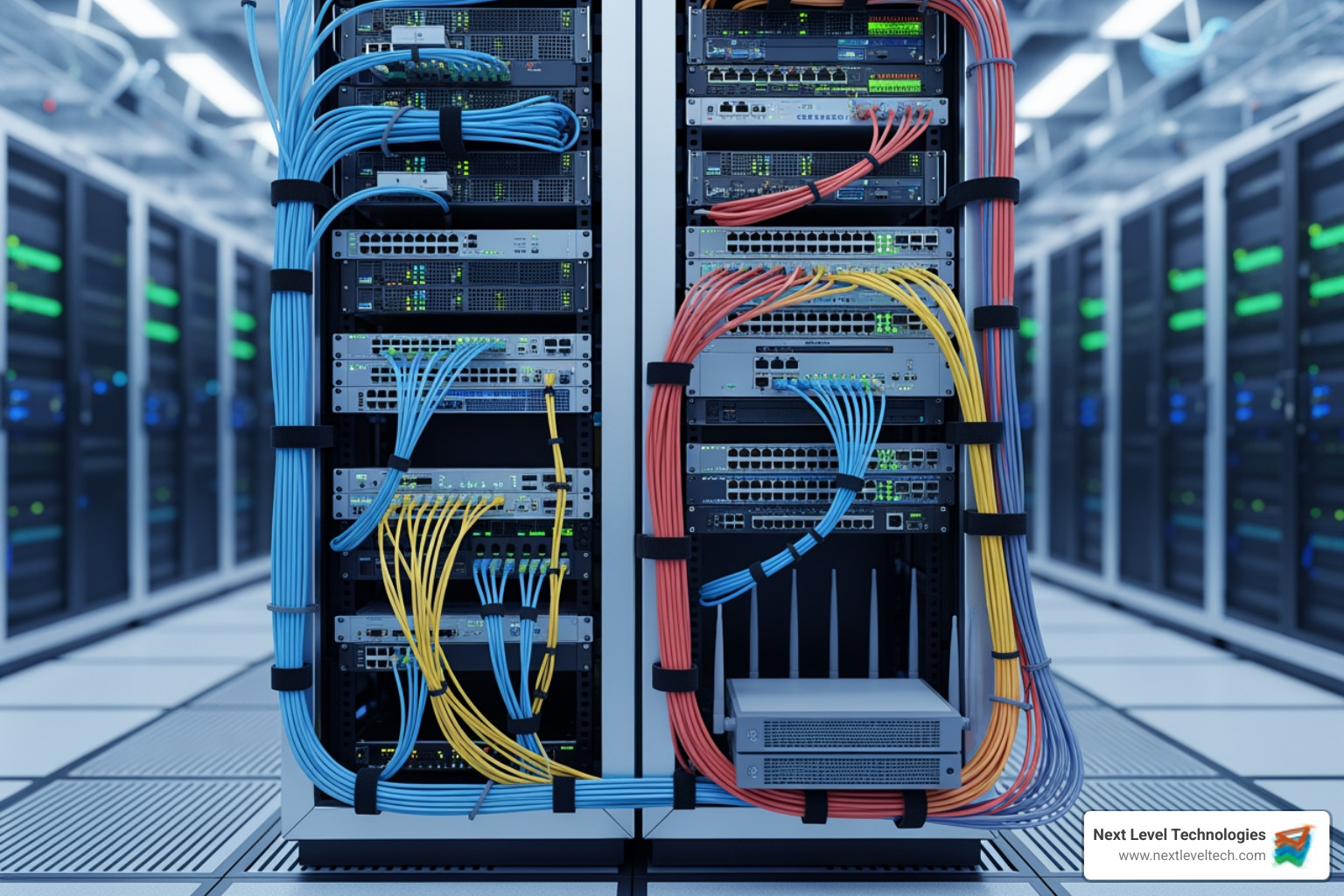From Cloud to Client: Understanding How SaaS Works
July 4, 2025

Master Computer Hardware Networking. Explore components, architectures, security, and best practices for robust networks. Get expert tips!
January 2, 2026

Unlock growth with smart IT solutions for small business. Boost productivity, secure data, and optimize costs with expert guidance.
January 1, 2026

Boost your practice with 7 amazing Healthcare Management IT Services. Secure data, improve efficiency & ensure compliance. Discover your IT partner today!
December 31, 2025
July 4, 2025
How does software as a service work? Simply put, Software-as-a-Service (SaaS) offers a convenient software distribution model through cloud computing. This means that instead of installing software directly on your devices, you can access it over the internet. Here's the quick overview:
SaaS is designed to simplify IT operations, offering businesses a reliable and efficient way to handle their technology needs.
As Steve Payerle, with experience in IT services, I've seen how SaaS can transform business operations by reducing downtime and increasing efficiency. I look forward to delving deeper into SaaS and how it can benefit your business.

Explore more about how does software as a service work:
To understand how Software as a Service (SaaS) works, think of it as a convenient way to access powerful software without the hassle of installing and maintaining it on your computer. Instead, all you need is an internet connection to tap into these cloud-based apps.
At the heart of SaaS is the cloud delivery model. This means that the software you use is hosted on remote servers, not on your local machines. Imagine a library where you can borrow books without having to own them. Similarly, with SaaS, you access applications over the internet, which are hosted and maintained by service providers. This setup saves you the trouble of managing hardware and software updates.
SaaS applications are typically accessed through web browsers. So, whether you're in Charleston, WV, Columbus, OH, or anywhere else, as long as you have an internet connection, you can use these applications on any device.
When it comes to paying for SaaS, the subscription basis is key. You don't buy the software outright; instead, you subscribe to it. This often means paying a recurring fee—monthly or annually. It's like subscribing to a magazine, where you pay regularly to keep receiving the latest issues.
There are different pricing models in the SaaS world. One popular model is pay-as-you-go, where your bill is based on your usage. If you use more, you pay more. If you use less, your costs go down. This flexibility can be a cost-effective solution for businesses, especially those that experience varying demands.
Another common approach is the tiered pricing model. Here, you choose a plan based on the features you need. For example, a basic plan might offer essential features, while a premium plan provides additional functionalities. This allows businesses to scale their software needs as they grow.
These subscription models make SaaS an attractive option for companies looking to manage their budgets effectively. Instead of a hefty upfront cost for software licenses, businesses can spread out their expenses over time, aligning costs with usage and needs.
In the next section, we'll explore the various common SaaS applications that businesses are using today, from email services to collaboration tools.
Software as a Service (SaaS) offers numerous benefits that make it an attractive option for businesses of all sizes. Let's explore the key advantages that make SaaS a preferred choice for many organizations.
One of the standout features of SaaS is its unparalleled accessibility and flexibility. With SaaS, you can access your applications from anywhere with an internet connection, whether you're in an office in Charleston, WV, or on a business trip in Columbus, OH. This means you can work from home, a café, or even while traveling. Remote access is a game-changer for businesses with a "work-from-anywhere" culture, enabling employees to collaborate seamlessly across different locations and time zones.
Moreover, SaaS applications are designed to be scalable. As your business grows, you can easily add more users or features without the need for significant hardware upgrades or additional software installations. This flexibility allows your business to adapt quickly to changing needs, ensuring that you're always equipped with the tools necessary to succeed.
One of the most appealing aspects of SaaS is its cost efficiency. Unlike traditional software that often requires hefty upfront investments for licenses and hardware, SaaS operates on a subscription basis. This means you pay a regular fee—usually monthly or annually—allowing your business to manage expenses more predictably. The lower upfront costs make SaaS accessible to small and medium-sized businesses, enabling them to compete with larger enterprises without a significant financial burden.
Furthermore, SaaS typically results in reduced ongoing costs. Since the software and its infrastructure are managed by the vendor, there's no need for your business to invest in on-premise hardware or dedicated IT resources for software maintenance. This translates into savings on maintenance and operational costs, freeing up resources for other strategic initiatives.
With SaaS, you can say goodbye to the hassle of manual updates and maintenance. Automatic updates are a hallmark of SaaS solutions. The software provider takes care of updates and patch management, ensuring you always have access to the latest features and security improvements without any extra effort on your part. This means your in-house IT team can focus on more strategic tasks rather than routine maintenance.
Moreover, SaaS providers typically offer vendor-managed infrastructure. This means they handle all the technical stuff—servers, storage, and security—so you don't have to. It's like having an expert IT team on standby, allowing your business to focus on what it does best.
In summary, the advantages of SaaS—from easy access and work-from-anywhere flexibility to cost efficiency and automatic updates—make it an appealing choice for businesses looking to streamline operations and reduce costs. With SaaS, you get the benefits of powerful software without the headaches of managing hardware and updates.
Next, we'll take a closer look at some common SaaS applications that are changing the way businesses operate, including popular options like Google Workspace and Salesforce.
Software as a Service (SaaS) has become an integral part of how businesses operate. By utilizing cloud-based apps, companies can streamline processes, improve collaboration, and improve customer relationships. Let's explore some common SaaS applications that have revolutionized the way organizations function.
Email services are among the most widely used SaaS applications. They allow users to send, receive, and store emails through web-based platforms. Services like Gmail and Outlook are prime examples, providing businesses with reliable, accessible, and easily manageable communication tools. These platforms eliminate the need for in-house email servers and ensure that employees can access their emails from any device with internet connectivity.
Customer Relationship Management (CRM) systems are a cornerstone of modern business operations. They help organizations manage interactions with current and potential customers by storing contact information, tracking sales leads, and recording business activities. Salesforce, a leading CRM platform, offers a comprehensive suite of tools that empower businesses to improve customer relationships, streamline sales processes, and improve customer service. With Salesforce, businesses can access real-time data and analytics, allowing them to make informed decisions and boost efficiency.
In an era where remote work is becoming the norm, collaboration tools have become essential. These SaaS applications enable teams to work together seamlessly, regardless of their physical location. Google Workspace and Microsoft Office 365 are two popular collaboration platforms that provide a range of tools for communication, document sharing, and project management. With features like real-time editing, cloud storage, and video conferencing, these platforms help teams stay connected and productive, whether they're in Charleston, WV, Columbus, OH, or anywhere else.

As businesses continue to adapt to the digital landscape, SaaS applications are playing a crucial role in their change. From email services and CRM systems to collaboration tools like Google Workspace and Microsoft Office 365, these applications are making it easier for teams to work together, regardless of location. By leveraging these tools, businesses can improve communication, improve productivity, and ultimately achieve greater success.
In the next section, we'll address some of the most frequently asked questions about SaaS, providing you with further insights into how this technology can benefit your business.
Software as a Service (SaaS) is like renting a house instead of buying one. Instead of owning software and installing it on your computer, you access it through the internet. This means you can use powerful tools and applications without needing to worry about updates or maintenance. The software lives in the cloud, and you pay a subscription fee to use it. This makes it simple and flexible for businesses of all sizes.
Yes, Netflix is a type of SaaS. It's a streaming platform that provides on-demand access to movies and TV shows. You can think of it as a digital library you can access anytime, as long as you have an internet connection. Unlike traditional TV, where you have to wait for shows to air, Netflix lets you watch what you want, when you want. This model is similar to other SaaS applications that offer a pay-as-you-go service.
SaaS has many benefits that make it appealing to businesses:
Easy Onboarding: Getting started with SaaS is as easy as creating an account and logging in. There's no need for complex installations or setups. This means new users can get up to speed quickly.
Real-Time Data: SaaS applications often provide real-time data and analytics. For example, a CRM system like Salesforce lets businesses track sales leads and customer interactions instantly, helping them make informed decisions.
Cloud-Based Software: Since SaaS runs in the cloud, you can access your applications from anywhere with an internet connection. This flexibility is especially useful for remote work environments, helping teams collaborate effectively no matter where they are.
By choosing SaaS, businesses can reduce costs, improve efficiency, and focus more on growing their operations rather than managing software.
In the next section, we'll dive into the conclusion, highlighting how Next Level Technologies can support your IT needs with comprehensive solutions.
As we've explored, Software as a Service (SaaS) offers numerous advantages that align perfectly with the needs of modern businesses. It's not just about accessing software; it's about changing how companies operate by leveraging cloud technology for greater efficiency and flexibility.
At Next Level Technologies, we understand the importance of seamless IT solutions that can adapt to your business's unique requirements. Our expertise in managed IT services allows us to provide comprehensive solutions that go beyond traditional software management. We specialize in supporting industries that are often overlooked, ensuring that all businesses, regardless of size or sector, have access to the best technology and support.
Our services include everything from regular software updates and security patches to real-time IT support, ensuring your business remains secure and efficient. With locations in Charleston, WV, Columbus, OH, and Worthington, OH, we are well-equipped to serve businesses across various regions.
By choosing Next Level Technologies, you are opting for a partner who is committed to helping your business thrive in a digital world. We offer custom solutions that are not only cost-effective but also scalable, allowing your business to grow without the hassle of managing complex IT infrastructure.
Ready to take your business to the next level with reliable, efficient, and comprehensive IT solutions? Contact us today to learn more about how we can support your IT needs and help your business succeed.
Master Computer Hardware Networking. Explore components, architectures, security, and best practices for robust networks. Get expert tips!
January 2, 2026
Unlock growth with smart IT solutions for small business. Boost productivity, secure data, and optimize costs with expert guidance.
January 1, 2026
Next Level Technologies was founded to provide a better alternative to traditional computer repair and ‘break/fix’ services. Headquartered in Columbus, Ohio since 2009, the company has been helping it’s clients transform their organizations through smart, efficient, and surprisingly cost-effective IT solutions.
